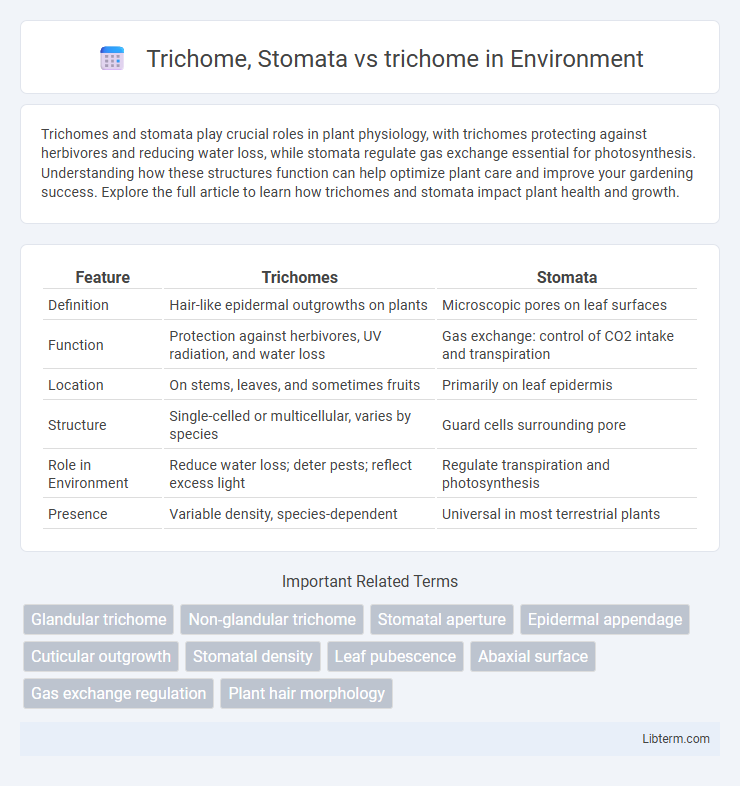Trichomes and stomata play crucial roles in plant physiology, with trichomes protecting against herbivores and reducing water loss, while stomata regulate gas exchange essential for photosynthesis. Understanding how these structures function can help optimize plant care and improve your gardening success. Explore the full article to learn how trichomes and stomata impact plant health and growth.
Table of Comparison
| Feature | Trichomes | Stomata |
|---|---|---|
| Definition | Hair-like epidermal outgrowths on plants | Microscopic pores on leaf surfaces |
| Function | Protection against herbivores, UV radiation, and water loss | Gas exchange: control of CO2 intake and transpiration |
| Location | On stems, leaves, and sometimes fruits | Primarily on leaf epidermis |
| Structure | Single-celled or multicellular, varies by species | Guard cells surrounding pore |
| Role in Environment | Reduce water loss; deter pests; reflect excess light | Regulate transpiration and photosynthesis |
| Presence | Variable density, species-dependent | Universal in most terrestrial plants |
Introduction to Trichomes
Trichomes are microscopic hair-like structures found on the surface of plants, serving as a defense mechanism against herbivores and environmental stress. Unlike stomata, which are pores involved in gas exchange and transpiration, trichomes provide physical protection and can secrete substances that deter pests. These specialized epidermal outgrowths vary in density, shape, and function, playing a critical role in plant adaptation and survival.
The Structure and Function of Trichomes
Trichomes are small hair-like structures on the surface of plants that serve multiple functions, including protection against herbivores, reducing water loss, and reflecting excess light. Unlike stomata, which are pores involved in gas exchange and transpiration regulation, trichomes are primarily physical barriers and can also secrete substances that deter pests or attract pollinators. Structurally, trichomes vary widely, from glandular types producing chemical compounds to non-glandular types providing mechanical defense.
Types of Trichomes in Plants
Trichomes in plants are specialized epidermal structures that serve various functions such as protection against herbivores, reduction of water loss, and UV defense. Unlike stomata, which primarily regulate gas exchange and transpiration, trichomes are hair-like outgrowths that can be glandular or non-glandular, with types including capitate, peltate, and stellate trichomes. Each type of trichome produces different compounds or offers distinct protective benefits, contributing to the plant's adaptability and survival.
Introduction to Stomata
Stomata are microscopic pores found on the surface of plant leaves and stems, primarily responsible for gas exchange and regulating water loss through transpiration. Unlike trichomes, which are hair-like epidermal outgrowths that protect plants from herbivores and reduce water loss by creating a microenvironment, stomata consist of guard cells that open and close to control the intake of carbon dioxide and the release of oxygen. The efficient functioning of stomata is crucial for photosynthesis, maintaining plant homeostasis, and adapting to environmental stress conditions.
The Structure and Function of Stomata
Stomata are microscopic pores primarily located on the leaf epidermis, consisting of two guard cells that regulate gas exchange and transpiration by opening and closing the pore. Unlike trichomes, which are hair-like structures that protect against herbivory and reduce water loss, stomata play a crucial role in photosynthesis by controlling the intake of carbon dioxide and release of oxygen. The dynamic structure of stomata enables plants to balance water conservation with the need for efficient gas exchange, essential for plant growth and survival.
Trichome vs Stomata: Key Differences
Trichomes are hair-like structures on plant surfaces that primarily function in protection against herbivores and environmental stress, while stomata are microscopic pores on leaves and stems responsible for gas exchange and transpiration. Unlike stomata, which regulate photosynthesis and water loss through opening and closing mechanisms, trichomes provide physical defense and can secrete substances that deter pests. These fundamental differences highlight trichomes' role in defense and microclimate modification versus stomata's critical function in plant respiration and water regulation.
Roles of Trichomes in Plant Defense
Trichomes play a crucial role in plant defense by providing a physical barrier against herbivores and reducing water loss through transpiration. Unlike stomata, which are primarily involved in gas exchange and water regulation, trichomes can secrete toxic or sticky substances that deter insect attacks and prevent fungal infections. Their varied structures, such as glandular or non-glandular trichomes, enhance a plant's resistance to environmental stress and pathogen invasion.
Stomata and Plant Gas Exchange
Stomata are microscopic pores on plant leaves that regulate gas exchange, allowing carbon dioxide to enter for photosynthesis and oxygen to exit as a byproduct. Unlike trichomes, which serve primarily as physical barriers against herbivores and reduce water loss, stomata actively control plant transpiration and internal water balance through opening and closing mechanisms. Efficient stomatal function is crucial for optimizing photosynthetic rates and maintaining plant health in varying environmental conditions.
Trichome and Stomata Evolutionary Perspectives
Trichomes and stomata represent key adaptations in plant evolution, serving distinct yet complementary roles in environmental interaction. Trichomes, hair-like epidermal outgrowths, evolved primarily to protect plants from herbivores, UV radiation, and water loss, demonstrating adaptive responses to ecological pressures. In contrast, stomata facilitate gas exchange and transpiration, with their evolutionary origin marking a pivotal advancement in terrestrial plant colonization by optimizing photosynthetic efficiency and water regulation.
Applications and Importance in Agriculture and Botany
Trichomes and stomata serve distinct roles in plant physiology, with trichomes primarily protecting against herbivores, reducing water loss, and reflecting excess light, while stomata regulate gas exchange and transpiration. In agriculture, trichome density can enhance crop resistance to pests and environmental stress, improving yield and reducing pesticide reliance. Botanical research leverages stomatal behavior to understand plant responses to climate change, enabling the development of drought-resistant cultivars crucial for sustainable farming.
Trichome, Stomata Infographic

 libterm.com
libterm.com